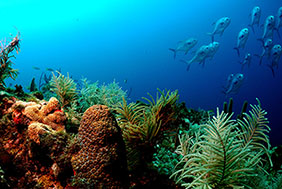Featured Archive - 2020 Publications
Below is a sampling of publications generated by NOAA's coral ecosystem activities in 2020. To access a complete list of NOAA coral ecosystem related publications, use the CoRIS Geoportal
(https://www.coris.noaa.gov/search/) search tool.
Recent losses of Dendrogyra cylindrus from the wild have been due largely to the panzootic of Stony Coral Tissue Loss Disease (SCTLD). In 2016, a multi-institutional collaboration began rescuing the remaining genotypes from the wild and placing them into ex situ and in situ nurseries. NOAA NOS NCCOS Coral Health and Disease Program (Charleston SC) conducted exploratory treatments to recover and rehabilitate D. cylindrus genotypes. This NOAA Technical Memorandum chronicles over four years (2016-2019) and seven collection and rescue events, experimental treatments, and rehabilitation of Dendrogyra cylindrus genotypes afflicted with SCTLD from Florida reefs.
Florida's Coral Reef stretches approximately 360 linear miles from St. Lucie Inlet in Martin County past Key West to the Dry Tortugas, including Biscayne National Park, the Florida Keys National Marine Sanctuary, and the Southeast Florida Coral Reef Ecosystem Conservation Area.
In 2014, NOAA Coral Reef Watch wrote about the prospect for a 2014-2015 El Niņo which, while not fully formed, helped start a three-year global coral bleaching event. The 2014-2017 global coral bleaching event was the third ever documented and is currently on record as the longest, most widespread, and most damaging bleaching event. It affected more coral reefs than any previous global bleaching event. In some coral reef areas, including reefs that had never bleached before, heat stress was the highest ever recorded, lasted for many months, and caused mass bleaching reef-wide.
Stony coral tissue loss disease was first observed in south Florida in 2014. As of September 2020, it has spread to 13 Caribbean countries and territories. The outbreak is unique due to its large geographic range, extended duration, rapid progression, high rates of coral mortality, and the number of species affected. Once infected, coral colonies typically die within weeks to months. While the cause of the disease is still unknown, it is believed that the pathogen may have a bacterial component due to its response to antibiotic treatments. Stony Coral Tissue Loss Disease can be transmitted to other corals through direct contact and water circulation. Recently, leadership from Indo-Pacific countries and territories shared concerns that the disease could spread into the region.
In response to the National Academies of Sciences, Engineering, and Medicine study on coral interventions, NOAA developed an action plan. The NOAA Action Plan on Coral Interventions will guide how NOAA approaches coral interventions in the next one to three years. The plan encompasses four actions for NOAA: (1) research and test priority interventions, (2) develop local or regional structured decision support, (3) review policy implications of coral interventions, and (4) invest in infrastructure, research, and coordination.
A Manager's Guide to Coral Reef Restoration Planning and Design supports the needs of reef managers seeking to begin restoration or assess their current restoration program. The Guide is aimed at reef resource managers and conservationists, along with everyone who plans, implements, and monitors restoration activities.
NOAA CRCP recently released a set of Local Manager Reports summarizing estimates of coral reef ecological resilience and social vulnerability for the US Pacific. Extending the results of these reports, NOAA researchers compare the resilience metrics to a diversity of other metrics for prioritizing management actions under a regime of resilience-based-management (RBM). Using efficiency frontier analysis, they show that the resilience metrics provide a robust method of prioritizing effort in RBM that successfully generates "win-win" tradeoffs across a diversity of concerns.
The purpose of the report card is to communicate the importance of conserving coral reef habitat in the Gulf of Mexico, and the report card is available in English and Spanish. Currently, different organizations throughout the Gulf of Mexico monitor coral reef ecosystems using different methods which complicates comparisons; therefore, the report card is considered preliminary.
Many common chemicals used in sunscreen products to filter or block harmful ultraviolet (UV) radiation, or UV filters, have been found to negatively impact coral reefs and other aquatic ecosystems. Perhaps the most well-known of these chemicals are oxybenzone and octinoxate, however there are a number of additional compounds contained in these products which threaten corals and other marine life. These chemicals are often carried into the ocean by those wearing sunscreen who go swimming, and are also discharged by wastewater treatment facilities.


